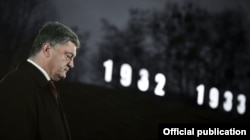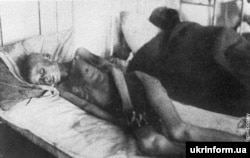Like many cinematic love stories, Bitter Harvest features passionate kisses, vows of fidelity, and heart-wrenching scenes of separation as turmoil engulfs a pastoral homeland.
Think Doctor Zhivago, except instead of the Russian Revolution, this film is set during the Holodomor -- the famine that killed millions in Ukraine in the 1930s and that shadows the country's relationship with Moscow to this day.
The film is being released -- in U.S. and British theaters this month -- amid another tumultuous chapter in the relationship: nearly four years of conflict between government forces and Russia-backed separatists that has left more than 9,750 dead in the east, and the Crimean Peninsula in Russia's hands.
Canadian-Ukrainian director George Mendeluk insists that his film is first and foremost a love story.
"It in some ways pays homage to Doctor Zhivago: The love story is up front, the Holodomor in the background," said Mendeluk, 68, whose film credits include the 1980 political thriller The Kidnapping Of A President.
But the film, featuring British actors Max Irons, Samantha Barks, and Terence Stamp, takes on a subject that many Ukrainians consider a genocide, a catastrophe engineered by Soviet leader Josef Stalin to consolidate communist power and wipe out any inkling of Ukrainian independence.
"The movie takes on a different dimension now, because even though in the film we talk about Stalin, and we show Stalin and how he orchestrated this artificial famine, what really is evident now is that, with the invasion of the Crimea and eastern Ukraine, it's the same old story, but repeating itself," Mendeluk said.
Untold On Film
Hearty peasant men scything golden sheaves of wheat. Ruddy-faced women lugging bags of grain on their backs to windmills standing under cloudless skies. A man and woman kissing passionately in a forest, giving way to scowling Red Army soldiers on horseback.
These are some of opening scenes of the film, which tells a fictional story of an artistically inclined peasant boy named Yuri (played by Irons) who is separated from his childhood sweetheart Natalka (played by Barks).
WATCH: The official trailer for Bitter Harvest
He struggles to return to her as the Red Army enforces Stalin's order aimed at collectivizing Ukraine's agricultural output, a policy that resulted in famine and millions of deaths -- through hunger, summary executions, or exile to Siberian labor camps.
The film ends in 1933, when the death toll reached its climax.
Richard Bachynsky-Hoover, the film's co-author, said he first came up with the story concept in 1999 when he traveled for Ukraine for the first time.
Raised in Ontario, Canada, by second-generation Ukrainian immigrants, Bachynsky-Hoover, 59, aspired to be an illustrator but ended up working odd jobs in construction. Later, he became a small-time actor, appearing in Canadian TV shows and movies, including a 1999 film directed by Mendeluk.
The year earlier he had married the daughter of a Ukrainian immigrant, leading him to travel to Ukraine in 1999 and begin to learn about his ethnic heritage. In 2004, he spent weeks on Kyiv's streets during the Orange Revolution.
Bachynsky-Hoover said he started drafting what would become Bitter Harvest, scribbling ideas down on napkins and studying the history of the period the story is set in, and the fate of his relatives.
"During the Orange Revolution, I found out, you know, that this country has suffered too much and that no one has ever done a film about the Holodomor," Bachynsky-Hoover said.
In 2008, three years after moving to Kyiv full-time, he had enough pieces to begin shopping his film idea to Ukrainian government officials, seeking financing.
The government of then-Prime Minister Viktor Yanukovych had no interest, he said, nor did any of the wealthy Ukrainian businessmen he approached.
In 2011, Bachynsky-Hoover said he approached Ian Ihnatowycz, a Toronto-based investor whose parents fled Lviv during World War II and emigrated to Canada in 1948. He committed to financing production of the $21 million film in its entirety.
"This was an opportunity, and there was a strong reason to make the West aware of the atrocities that Stalin had committed, and I thought it was particularly important to give the typical Western movie viewer some context about modern-day Ukraine and the situation that Ukraine faces," Ihnatowycz said.
The following year, Mendeluk said, he was contacted by Bachynsky-Hoover. With Ihnatowycz's financial backing, Mendeluk agreed to do the film.
The screenplay went through 12 different scripts before the writers settled on a final version, and filming began in the summer of 2013, Mendeluk said. Many of the key scenes of Ukrainian countryside and bucolic villages were filmed on the grounds of an outdoor ethnographic museum in Pyrohiv, a village located 45 minutes from Kyiv.
Oleksandr Pecherytsia, a Ukrainian actor who plays a peasant and best friend of the main hero, said he felt a special obligation in appearing the film. The stories it tells, he said, are the same stories that a dwindling number of older Ukrainians remember firsthand.
"I know about the Holodomor not from books but from the stories of my grandparents, who were forced to roam from one region to another," he said. "Ukraine had the most fertile land, everybody bought its corn, and suddenly there was famine in Ukraine."
A Tragedy Exposed
The subject of the famine of 1932-33, which struck many grain-producing areas of the Soviet Union, is fraught with controversy when it comes to Ukraine. The widespread belief there -- held furtively during the Soviet era and aired openly after independence in 1991 -- is that famine was man-made, engineered by the Politburo under Stalin's leadership to bring independence-minded Ukrainians to heel.
The result was that Ukrainians would suffer greater losses during the famine than any other Soviet republic. From 2.4 to 7.5 million Ukrainians died, depending on the source; some estimates push the toll even higher.
The famine was downplayed by Soviet authorities, but in the Soviet Union's dying days, historians began to talk more openly about the toll and its causes. To this day, however, officials in Russia have resisted labeling it a man-made catastrophe.
The policy was "that this was sort of a vague bland Soviet tragedy. You emphasize the Russian, Kazakhs also died rather than admitting something specific had happened in Ukraine," said Timothy Snyder, a Yale University historian and author of the 2010 book Bloodlands: Europe Between Hitler And Stalin.
In recent years, the Russian government under President Vladimir Putin has sought to publicly reexamine Soviet history -- and Stalin in particular -- at times glossing over some of its more horrific chapters.
Culture Minister Vladimir Medinsky, for example, has condemned any critical examination of the Soviet period. In 2015, he panned a British film about a disgraced Soviet agent that had been dubbed into Russian and was to be released in Russia. In a statement posted to the ministry's website at the time, he sarcastically referenced the Ukrainian famine.
"Everything in the film is in its place: Stalin arranges the Holodomor especially for Ukraine and kills 25,000 people every day; starving children eat their weaker classmates; it is forbidden to investigate crimes in the Soviet Union because 'we don't have murders, they happen only under capitalism,'" Medinsky wrote.
In October of 2016, the Kremlin-backed news site Sputnik published a blunt opinion piece that asserted that the Holodomor was a hoax "invented by the West in close cooperation with Nazi Germany and pro-Nazi Ukrainian nationalists."
In Ukraine, the parliament passed legislation declaring the famine to be genocide in 2006, and then-President Viktor Yushchenko signed it into law. That conclusion is now shared by two dozen other countries. November 26 is officially observed as the Day In Memory Of The Victims Of The Holodomor.
Yanukovych's political party, the Party of the Regions, did not back the measure, instead backing earlier, unsuccessful legislation that stopped short of the genocide declaration.
Despite the classification, there was no unanimity among members of the government. Yanukovych himself frequently downplayed any suggestion that the famine was engineered. His last education minister insisted the death toll was exaggerated, angering nationalists.
That attitude has changed not only because of the recent events in Ukraine. There's also greater recognition of the Holodomor and other tragedies, in part due to the broad reach of film and other artistic avenues.
"We are starting to create the story," Yevhen Nyshchuk, Ukraine's culture minister, told RFE/RL. "The world community should know that Ukrainians lived through such a tragedy."
Maidan Shoot
The film's final shooting in Ukraine came as the country convulsed in turmoil. In November 2013, Yanukovych, then president, spurned a trade agreement with the European Union for closer ties with Russia. That decision sparked four months of often-violent protests in Kyiv's center that culminated with Yanukovych's ouster in February 2014.
Mendeluk, who helped write the final version of the screenplay in addition to directing, said his crew, which also shot in England, did its final filming in February as protests raged in downtown Kyiv.
He said he had to repeatedly remind his local crew not to focus on the shoot, not the demonstrations. Several regularly showed up to work smelling of burnt rubber, he said, from the tires set ablaze by protesters.
All the main figures behind the film insist that the timing of its release is coincidental. As Bachynsky-Hoover said, the story was conceived of more than a decade ago.
Still, Russia's relationship with Ukraine -- in 1933 or in 2017 -- lurks in the background.
"Whatever the contemporary politics are, more than 3 million people starved to death in Soviet Ukraine, in horrifying circumstances. That is just the case," said Snyder, who has not seen the film yet. "One can evaluate that in different ways. You can understand it in different ways."
But if the first impulse is to dismiss such stories as information warfare, "there's just something inhuman in that," he added. "I would say this: That it wouldn't be a bad thing if Russians, Ukrainians, and others knew a bit more about what happened in the 1930s."















